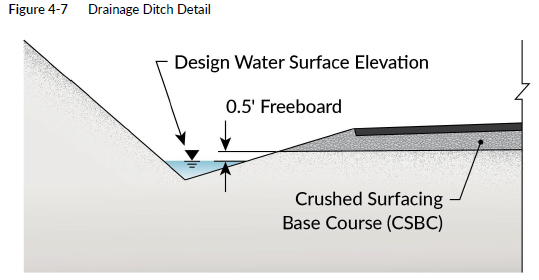Roadside ditches are generally located alongside uncurbed roadways with the primary purpose of conveying runoff away from the roadway. Ditches shall be designed to convey the 10-year recurrence interval with 0.5 foot of freeboard (from the ditch design WSEL to the bottom of the pavement subgrade or ditch spill) and a maximum side slope of 2 H:1 V (Figure 4-7). Side slopes of 4H:1V or flatter are desirable; see WSDOT Design Manual Exhibit 1239-4 for requirements for slopes steeper than 4H:1V.
The preferred cross section of a ditch is trapezoidal; however, a “V” ditch that meets the design requirements can also be used where ROW is limited. In those cases where the grade is flat, preventing adequate freeboard, the depth of channel should still be sufficient to remove the water without saturating the subgrade shoulder.
If the freeboard is less than 0.5 foot, a deviation is required, unless there is a strong justification by the designer for the RHE and Region Maintenance to allow the installation of an impermeable ditch liner or an underdrain system underneath the ditch to prevent saturation of the roadway subgrade.
To maintain the integrity of the channel, ditches are usually lined. See HDS-4 and HEC-15 for additional guidance.
Ditches should not be confused with biofiltration swales. In addition to collecting and conveying drainage, biofiltration swales provide runoff treatment by filtering out sediment. (See the Highway Runoff Manual for design guidance for biofiltration swales.) Roadside ditches are to be designed so the integrity or geometry of the roadway is not compromised.
A drainage Inlet can be placed at a low point or at the end of the ditch to convey the water to its intended discharge point. Ditch inlets operate as weirs under low water depth conditions or as orifices at greater depths. Orifice flow begins at depths dependent on the grate size. Flows in a transition stage could yield water depths fluctuating between weir and orifice control.
Ditch inlets are more susceptible to clogging from sediments and debris. Ensure that the grate is adequately sized to satisfy the ditch freeboard requirement or prevent